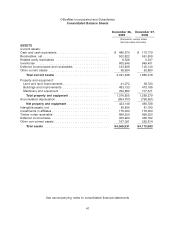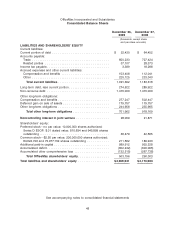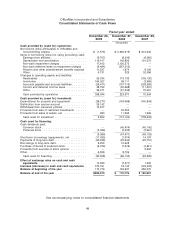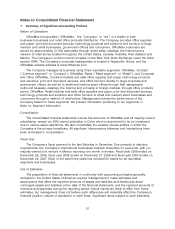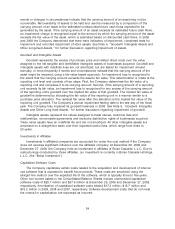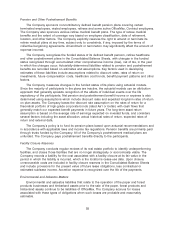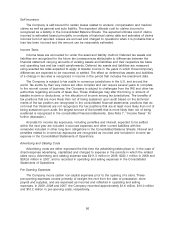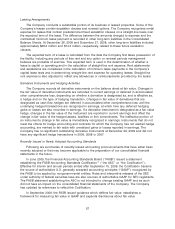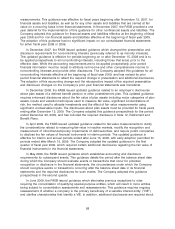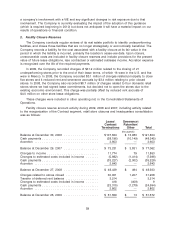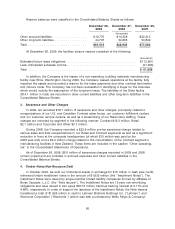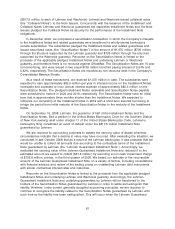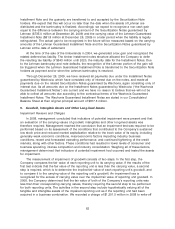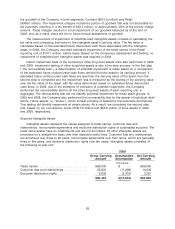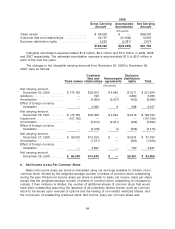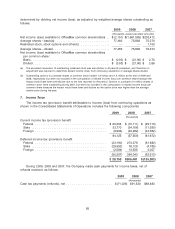OfficeMax 2009 Annual Report Download - page 61
Download and view the complete annual report
Please find page 61 of the 2009 OfficeMax annual report below. You can navigate through the pages in the report by either clicking on the pages listed below, or by using the keyword search tool below to find specific information within the annual report.Leasing Arrangements
The Company conducts a substantial portion of its business in leased properties. Some of the
Company’s leases contain escalation clauses and renewal options. The Company recognizes rental
expense for leases that contain predetermined fixed escalation clauses on a straight-line basis over
the expected term of the lease. The difference between the amounts charged to expense and the
contractual minimum lease payment is recorded in other long-term liabilities in the Consolidated
Balance Sheets. At December 26, 2009 and December 27, 2008, other long-term liabilities included
approximately $68.2 million and $74.3 million, respectively, related to these future escalation
clauses.
The expected term of a lease is calculated from the date the Company first takes possession of
the facility, including any periods of free rent and any option or renewal periods management
believes are probable of exercise. This expected term is used in the determination of whether a
lease is capital or operating and in the calculation of straight-line rent expense. Rent abatements
and escalations are considered in the calculation of minimum lease payments in the Company’s
capital lease tests and in determining straight-line rent expense for operating leases. Straight-line
rent expense is also adjusted to reflect any allowances or reimbursements provided by the lessor.
Derivative Instruments and Hedging Activities
The Company records all derivative instruments on the balance sheet at fair value. Changes in
the fair value of derivative instruments are recorded in current earnings or deferred in accumulated
other comprehensive loss, depending on whether a derivative is designated as, and is effective as,
a hedge and on the type of hedging transaction. Changes in fair value of derivatives that are
designated as cash flow hedges are deferred in accumulated other comprehensive loss until the
underlying hedged transactions are recognized in earnings, at which time any deferred hedging
gains or losses are also recorded in earnings. If a derivative instrument is designated as a fair value
hedge, changes in the fair value of the instrument are reported in current earnings and offset the
change in fair value of the hedged assets, liabilities or firm commitments. The ineffective portion of
an instrument’s change in fair value is immediately recognized in earnings. Instruments that do not
meet the criteria for hedge accounting and contracts for which the Company has not elected hedge
accounting, are marked to fair value with unrealized gains or losses reported in earnings. The
Company has no significant outstanding derivative instruments at December 26, 2009 and did not
have any significant hedge transactions in 2009, 2008 or 2007.
Recently Issued or Newly Adopted Accounting Standards
Following are summaries of recently issued accounting pronouncements that have either been
recently adopted or that may become applicable to the preparation of our consolidated financial
statements in the future.
In June 2009, the Financial Accounting Standards Board (‘‘FASB’’) issued a statement
establishing the FASB Accounting Standards Codification (‘‘the ASC’’ or ‘‘the Codification’’).
Effective for interim and annual periods ended after September 15, 2009, the Codification became
the source of authoritative U.S. generally accepted accounting principles (‘‘GAAP’’) recognized by
the FASB to be applied by nongovernmental entities. Rules and interpretive releases of the SEC
under authority of federal securities laws are also sources of authoritative GAAP for SEC registrants.
The FASB statement establishing the ASC is not intended to change existing GAAP and as such
did not have an impact on the consolidated financial statements of the Company. The Company
has updated its references to reflect the Codification.
In September 2006, the FASB issued guidance which defines fair value, establishes a
framework for measuring fair value in GAAP and expands disclosures about fair value
57


